
 |
|
#1
|
|||
|
|||
|
Living in northwest England, I don't need to worry about humidifying my guitars. The relative humidity is always high: usually in the 55-80% range, and sometimes even higher. In my ignorance, I discovered the shocking effect that such high humidity can have by keeping my Taylor 210eDLX on the wall for 6 months. It's taken many more months to bring it back to its original condition: I've already recounted the story here:
High humidity problems One option is to dehumidify the room where I keep the guitars, and I’ve tried that. But it's a large room, its temperature varies quite a lot, the almost constant whirr of the dehumidifier drove us crazy, and our sinuses began to object. Besides, it seemed like a sledgehammer-to-crack-a-nut solution. I resolved to keep the guitars in their cases and find a convenient way of dehumidifying them in their cases using 10g reusable silica gel packs. To monitor the relative humidity inside the body of the guitar, I modified a digital hygrometer by super-glueing a small flat thin piece of wood to the end of it. The hygrometer slides between the strings, and the flat bit of wood stops it falling in. The question then is: where and how to store the silica gel packs, and how many? Ideally they should be inside the body of the guitar. (It's not good enough to put them in the headstock space of the case, because there's insufficient air circulation in the case. The RH can be 30% in the headstock compartment and 65% in the main body of the case at the same time!) I tried using two of those plastic gadgets for humidifying guitars - the Planet Waves one, and the Music Nomad 'Humitar', removing their sponges and replacing them with gel packs - so they work in reverse, as dehumidifiers. And they work quite well, but you can only get two 10g packs inside, and even then it's a squeeze. The Planet Waves is too small and you have to scrunch up the gel packs quite a lot to get them in, so they soon fall to bits. The Humitar is better in that respect, and has a more convenient hinged top - but still, it will only hold two packs. Next I tried a Boveda pouch. This seemed like a useful design - a kind of folding wallet made of a thin material, with two thin and floppy pouches big enough to hold several packs. But because the material is intended to be leak-resistant, the airflow between the space inside the pouch and the space outside is very restricted, so the system is very slow to respond to humidity changes. I thought I could do better by making my own version using little jute bags - very cheap, very porous, and readily obtainable through Amazon. Here's one, below - the photo also shows the modified hygrometer: 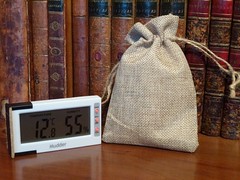 The bags have drawstrings to close the top - first job is to remove them, but keep them for sewing later. Two bags are placed flat against each other, and stitched together along a line about a couple of cm from the top, stitching only one side of each bag of course (so that each bag is open at the top). The result looks like this: 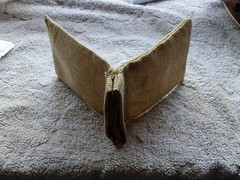 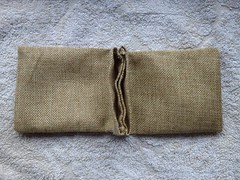 Slip a 10g silica gel pack into each pocket (or more than one pack, according to need): 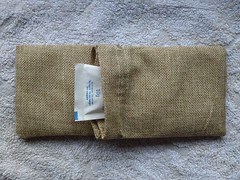 Fold the whole thing in two, with the open tops on the inside:  Push it into the soundhole, straddling two strings. Each separate pocket passes between an outer pair of strings, and the two open tops push into the space between the middle pair of strings, like this: 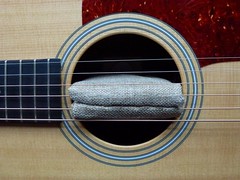 Finally, add the hygrometer, positioned so it measures the relative humidity inside the body of the guitar: 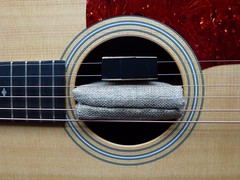 Once the relative humidity has been stabilised at under 50%, I've found that two 10g silica gel packs will keep it there for at least a week. By that time I've found that the packs have usually risen in weight to about 12g, after which they absorb water more slowly - so I tend to change them at that point. (I believe 14g is the maximum they can reach.) There's plenty of room in each pocket for more than one pack if needed. All this is of no use at all if you live in Arizona of course! But in NW England I know the RH will never be low, so all I need to be concerned with is dehumidification.
__________________
Last edited by N+1; 07-25-2017 at 09:09 AM. |
|
#2
|
|||
|
|||
|
I live in NW England about 1 mile from the beach and Irish Sea. We have high humidity all year round.
The exact same thing happened to my Ibanez dread whereby over the course of around a year the action at the 12th fret low E went up from around 2 mm (set by my guitar tech) to around 3.5 mm. I'm pretty sure it is caused by the top swelling due to high humidity. My Yamaha AC3M seems unaffected but the Ibanez is a lighter build and the top is quite a bit bigger.
__________________
Yamaha AC3M Acoustic Guitar Gretch G5220 Electromatic Squier Classic Vibe 50s Telecaster Squier Vintage Modified Telecaster Special Yamaha BB414 Bass |
|
#3
|
|||
|
|||
|
I live on the US southeast coast with high humidity but we have air conditioning on most of thr summer. There is about a month in the spring when the temp is too low for the AC but the humidity is still high. Can get to about 70 percent humidity.
|
|
#4
|
||||
|
||||
|
Great idea - I'm a fan of gel beads - I'm going to try this with gel beads right in the pouch and make sure it can't get wet on the cloth
__________________
Fazool "The wand chooses the wizard, Mr. Potter" Taylor GC7, GA3-12, SB2-C, SB2-Cp...... Ibanez AVC-11MHx , AC-240 |
|
#5
|
|||
|
|||
|
Quote:
However, it's now spent many weeks at a sustained 45-50% RH (and finally, as icing on its cake, a superb fine-tuned setup by one of the brilliant staff at Reidys of Blackburn), and it sounds seriously dazzling again. And it plays effortlessly, capable of being a rock and roll piledriver, or whispering with a feather-like delicacy.
__________________
|
|
#6
|
|||
|
|||
|
I can't think of any reason for not doing this, except it may affect the ease with which the pockets slide between the strings. The gel packs stay thin inside the pockets, so the pockets slip inside quite easily. If the beads are free to roam, as it were, they'll gather in a clump at the bottom of the pockets, and you might find it a bit more fiddly pushing them in. However, the clumsiest bit for me is pushing the stitched tops between the two middle strings. I haven't been doing this long enough to acquire the necessary knack, yet - having only completed the prototype a few days ago.
__________________
|
|
#7
|
|||
|
|||
|
Thanks for posting this. Here in Chicago it can get fairly humid during the summer but with air conditioning the humidity is moderate, but I don't like to run air conditioning unless it's really hot and sticky.
But you gave me a good idea with the planet waves thing. Why not use two planet waves doo-hickeys with the silica gel packs stuffed inside? While combined they may not have the volume of your sack idea, I'm wondering how well it could work in moderately humid areas?
__________________
Assuming is not knowing. Knowing is NOT the same as understanding. There is a difference between compassion and wisdom, however compassion cannot supplant wisdom, and wisdom can not occur without understanding. facts don't care about your feelings and FEELINGS ALONE MAKE FOR TERRIBLE, often irreversible DECISIONS 
|
|
#8
|
|||
|
|||
|
Quote:
Music Nomad Humitar When I was using the Planet Waves, on several occasions I found myself with little gel beads tumbling out of the split packs, especially after they'd been renewed in the oven.
__________________
|
|
#9
|
|||
|
|||
|
Quote:
1. In the process of dehumidifying a wet guitar, be prepared for quite a lot of gel pack changing. Looking back at my notes, I find I had to check the weight of the packs and change them every few days - they were removing 10-15 g of water every week. Once the RH gets down to the target level below 50%, it becomes a much more relaxed business, with minimal maintenance. 2. An hour and a half in an oven at 110 degrees seems to be enough to dry out the packs, and set the weight back to 10g.
__________________
|
|
#10
|
|||
|
|||
|
That is similar to what I do to keep my guitars humidified, only I use the flower beads and a fleece to drape over the strings. Fleece is hydrophobic and should not tend to tarnish the strings.
I would, however, be concerned that keeping my meter/gauge so close to the unit would result in inaccurate readings.
__________________
The Bard Rocks Fay OM Sinker Redwood/Tiger Myrtle Sexauer L00 Adk/Magnolia For Sale Hatcher Jumbo Bearclaw/"Bacon" Padauk Goodall Jumbo POC/flamed Mahogany Appollonio 12 POC/Myrtle MJ Franks Resonator, all Australian Blackwood Blackbird "Lucky 13" - carbon fiber '31 National Duolian + many other stringed instruments. |
|
#11
|
|||
|
|||
|
Quote:
1. The hygrometer is placed between the strings with the screen facing inwards towards the jute bag, so the back of the hygrometer (which is where the sensor is) faces out towards the free air space inside the body of the guitar. If you put it in the other way, there might be a problem such as you mention - although once the system inside the case has reached equilibrium I'd expect the difference to be small. 2. If I read the hygrometer in situ, then take the jute bag assembly out, close the lid immediately, and read the hygrometer again 15 minutes later, it agrees with the previous reading to within 1 percentage point.
__________________
|
|
#12
|
|||
|
|||
|
Brilliant little device! Thanks for posting your method...
I have been the victim of over-humidification when I lived in the mountains on Kauai (~500 inches of rainfall per annum, mostly in three months!)... not knowing how to adjust a truss rod nearly trashed my new handmade Mark Angus guitar; after 9 months of being over there, the neck looked like a severe ski-jump ramp! Fortunately, Mark was able to fix it, with considerable effort... afterwards, he handed me the guitar and added, sternly, "That lifetime guarantee? It is a CONTINENTAL guarantee!!!" This is the first viable, "real" solution to excess humidity that I have seen... Thanks again!
__________________
"Home is where I hang my hat, but home is so much more than that. Home is where the ones and the things I hold dear are near... And I always find my way back home." "Home" (working title) J.S, Sherman |
|
#13
|
|||
|
|||
|
Thanks for this info N+1.
I'm in Florida and in the winter, with the air conditioning off, RH gets over 60%. I haven't noticed a problem with it so far, but I'm going to try a Music Nomad Humitar with 2 10g packs--just to be safe.
__________________
Eastman E10-OO Eastman E20-P |
|
#14
|
|||
|
|||
|
Quote:
There's a good argument that slow dehumidification would be best for the guitar, and the Humitar with two 10g packs will eventually bring the in-case RH down below 50%. But a lot of water has to be absorbed in total (from the case as well as the guitar), and in practice when packs reach 12g they are a lot less effective at absorbing the moisture. So two packs can only absorb (realistically) about 4 or 5g maximum. So at the start, I'd recommend checking the weight of each pack every couple of days, and changing them when they reach 12g. Once you get down into the zone, of course, everything slows down and life can return (almost) to normal!
__________________
|
|
#15
|
|||
|
|||
|
Quote:
I wish I could think of a way of making the insertion of the jute bag pouches between the strings a bit more slick. It's a bit more fiddly than I'd like. Mind you, if you'd seen the fiasco I was engaged in while trying to suspend a single jute bag full of gel packs inside the sound hole, dangling from a thin stick laid across the strings ... now THAT was fiddly!
__________________
|